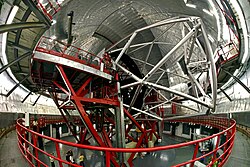Gran Telescopio Canarias

Gran Telescopio Canarias, 2008
|
|
| Organisation |
Instituto de Astrofísica de Canarias University of Florida National Autonomous University of Mexico |
|---|---|
| Location(s) | Roque de los Muchachos Observatory, La Palma, Spain |
| Coordinates | 28°45′23.8″N 17°53′31.3″W / 28.756611°N 17.892028°WCoordinates: 28°45′23.8″N 17°53′31.3″W / 28.756611°N 17.892028°W |
| Altitude | 2,267 m (7,438 ft) + 8 m (26 ft) pier |
| Built | 2002–2008 |
| First light | 2007-07-13 |
| Telescope style | Segmented Ritchey-Chrétien telescope |
| Diameter | effective =10.4 m (410 in) , maximum= 11,386.9 mm (448.30 in) |
| Collecting area | 78.54 m2 (845.4 sq ft) (74.14 m2 or 798.0 sq ft effective) |
| Focal length | 169.9 m (6,690 in) |
| Mounting | Altitude/azimuth |
| Website | http://www.gtc.iac.es/ |
|
|
|
|
[]
|
|
The Gran Telescopio Canarias (GranTeCan or GTC), also known as the Great Canary Telescope is a 10.4 m (410 in) reflecting telescope located at the Roque de los Muchachos Observatory on the island of La Palma, in the Canaries, Spain.
Construction of the telescope, sited on a volcanic peak 2,267 metres (7,438 ft) above sea level, took seven years and cost €130 million (£112 million). Its installation had been hampered by weather conditions and the logistical difficulties of transporting equipment to such a remote location. First light was achieved in 2007 and scientific observations began in 2009.
The GTC Project is a partnership formed by several institutions from Spain and Mexico, the University of Florida, the Universidad Nacional Autónoma de México, and the Instituto de Astrofísica de Canarias (IAC). Planning for the construction of the telescope, which started in 1987, involved more than 1,000 people from 100 companies.
As of 2015[update], it is the world's largest single-aperture optical telescope. The distribution of the availability of time to use the telescope meets its financial structure: 90% Spain, 5% Mexico and 5% the University of Florida.
The GTC began its preliminary observations on 13 July 2007, using 12 segments of its primary mirror, made of Zerodur glass-ceramic by the German company Schott AG. Later the number of segments was increased to a total of 36 hexagonal segments fully controlled by an active optics control system, working together as a reflective unit. Its Day One instrumentation was OSIRIS. Scientific observations began properly in May 2009.
...
Wikipedia
